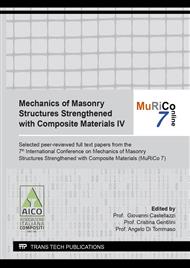[1]
Bonati, A., A. Franco, O. Coppola and G. De Luca, Strengthening of masonry structures: Current national and international approaches for qualification and design. KEM, 2019. 817 KEM: 501-506.
DOI: 10.4028/www.scientific.net/kem.817.501
Google Scholar
[2]
De Lorenzis, L., B. Miller, and A. Nanni, Bond of FRP laminates to concrete. ACI Mat. J., 2001. 98(3): 256-264.
Google Scholar
[3]
Yao, J., J.G. Teng, and J.F. Chen, Experimental study on FRP-to-concrete bonded joints. Compos. B. Eng., 2005. 36(2): 99-113.
DOI: 10.1016/j.compositesb.2004.06.001
Google Scholar
[4]
Chen, J.F. and J.G. Teng, Anchorage strength models for FRP and steel plates bonded to concrete. J. Struct. Eng., 2001. 127(7): 784-791.
DOI: 10.1061/(asce)0733-9445(2001)127:7(784)
Google Scholar
[5]
Sayed-Ahmed, E.Y., R. Bakay, and N.G. Shrive, Bond Strength of FRP Laminates to Concrete: State-of-the-Art Review. Electron. J. Struct. Eng., 2009. 9: 45-61.
DOI: 10.56748/ejse.9117
Google Scholar
[6]
Franco, A. and G. Royer-Carfagni, Effective bond length of FRP stiffeners. Int. J. Non Linear Mech., 2014. 60: 46-57.
DOI: 10.1016/j.ijnonlinmec.2013.12.003
Google Scholar
[7]
Ceroni, F., Pecce, M. Evaluation of Bond Strength in Concrete Elements Externally Reinforced with CFRP Sheets and Anchoring Devices. J. Compos. Constr., 2010. 14(5): 521-530.
DOI: 10.1061/(asce)cc.1943-5614.0000118
Google Scholar
[8]
Ceroni, F., Bond tests to evaluate the effectiveness of anchoring devices for CFRP sheets epoxy bonded over masonry elements. Compos. B. Eng., 2017. 113: 317-330.
DOI: 10.1016/j.compositesb.2017.01.042
Google Scholar
[9]
Arboleda, D., et al., Testing Procedures for the Uniaxial Tensile Characterization of Fabric-Reinforced Cementitious Matrix Composites. J. Compos. Constr, 2016. 20(3).
DOI: 10.1061/(asce)cc.1943-5614.0000626
Google Scholar
[10]
De Santis, S. and G. de Felice, Tensile behaviour of mortar-based composites for externally bonded reinforcement systems. Compos. B. Eng., 2015. 68: 401-413.
DOI: 10.1016/j.compositesb.2014.09.011
Google Scholar
[11]
Donnini, J. and V. Corinaldesi, Mechanical characterization of different FRCM systems for structural reinforcement. Constr. Build. Mater., 2017. 145: 565-575.
DOI: 10.1016/j.conbuildmat.2017.04.051
Google Scholar
[12]
Täljsten, B. and T. Blanksvärd, Strengthening of concrete structures with cement based bonded composites. NCF, 2008. 2(38): 133-153.
Google Scholar
[13]
Triantafillou, T.C. and C.G. Papanicolaou, Shear strengthening of reinforced concrete members with textile reinforced mortar (TRM) jackets. Mater. Struct., 2006. 39(1): 93-103.
DOI: 10.1007/s11527-005-9034-3
Google Scholar
[14]
Basalo, F., F. Matta, and A. Nanni, Fiber reinforced cementitious matrix composites for infrastructure rehabilitation. Composites & Polycon 2009, (2009).
Google Scholar
[15]
Babaeidarabad, S., G. Loreto, and A. Nanni, Flexural strengthening of RC beams with an externally bonded fabric-reinforced cementitious matrix. J. Compos. Constr. , 2014. 18(5):04014009.
DOI: 10.1061/(asce)cc.1943-5614.0000473
Google Scholar
[16]
Awani, O., A.E. Refai, and T. El-Maaddawy, Bond characteristics of carbon fabric-reinforced cementitious matrix in double shear tests. Constr. Build. Mater., 2015. 101: 39-49.
DOI: 10.1016/j.conbuildmat.2015.10.017
Google Scholar
[17]
Sen, R., Developments in the durability of FRP-concrete bond. Constr. Build. Mater., 2015. 78: 112-125.
Google Scholar
[18]
Myers, J.J., 12 - Durability of external fiber-reinforced polymer strengthening systems, in Durability of Composites for Civil Structural Applications, V.M. Karbhari, Editor. 2007, Woodhead Publishing. 247-283.
DOI: 10.1533/9781845693565.2.247
Google Scholar
[19]
Ombres, L., Analysis of the bond between Fabric Reinforced Cementitious Mortar (FRCM) strengthening systems and concrete. Compos. B. Eng., 2015. 69: 418-426.
DOI: 10.1016/j.compositesb.2014.10.027
Google Scholar
[20]
Arboleda, D., et al. Durability of fabric reinforced cementitious matrix (FRCM) composites. in Proceedings 7th Int. Conf. on FRP Comp. in Civil Eng., CICE. (2014).
Google Scholar
[21]
Ceroni, F., et al., Effects of Environmental Conditioning on the Bond Behavior of FRP and FRCM Systems Applied to Concrete Elements. J. Eng. Mech., 2018. 144(1): 04017144.
DOI: 10.1061/(asce)em.1943-7889.0001375
Google Scholar
[22]
Nobili, A. and C. Signorini, On the effect of curing time and environmental exposure on impregnated Carbon Fabric Reinforced Cementitious Matrix (CFRCM) composite with design considerations. Compos. B. Eng., 2017. 112: 300-313.
DOI: 10.1016/j.compositesb.2016.12.022
Google Scholar
[23]
Jeong, Y., J. Lee, and W. Kim, Modeling and Measurement of Sustained Loading and Temperature-Dependent Deformation of Carbon Fiber-Reinforced Polymer Bonded to Concrete. Materials, 2015. 8(2): 435-450.
DOI: 10.3390/ma8020435
Google Scholar
[24]
Choi, K.K., P. Meshgin, and M.M.R. Taha, Shear creep of epoxy at the concrete-FRP interfaces. Compos. B. Eng., 2007. 38(5-6): 772-780.
DOI: 10.1016/j.compositesb.2006.10.003
Google Scholar
[25]
Soliman, E., U.F. Kandil, and M.R. Taha, Limiting shear creep of epoxy adhesive at the FRP-concrete interface using multi-walled carbon nanotubes. Int. J. Adhes. Adhes., 2012. 33: 36-44.
DOI: 10.1016/j.ijadhadh.2011.09.006
Google Scholar
[26]
Houhou, N., et al. Durability of concrete/FRP bonded assemblies subjected to hydrothermal coupled creep ageing mechanisms: experimental and numerical investigations. in Transport Research Arena 2014. 2014. Paris.
Google Scholar
[27]
Meshgin, P., K.K. Choi, and M.M.R. Taha, Experimental and analytical investigations of creep of epoxy adhesive at the concrete-FRP interfaces. Int. J. Adhes. Adhes., 2009. 29(1): 56-66.
DOI: 10.1016/j.ijadhadh.2008.01.003
Google Scholar
[28]
Mazzotti, C. and M. Savoia, Stress Redistribution Along the Interface Between Concrete and FRP Subject to Long-term Loading. Adv. Struct. Eng., 2009. 12(5): 651-661.
DOI: 10.1260/136943309789867926
Google Scholar
[29]
Bonati, A., A. Franco, L. Schiavi, and A. Occhiuzzi. Experimental investigation of the long-term behaviour of Fabric Reinforced Matrix systems, in Brick and Block Masonry - From Historical to Sustainable Masonry, J. Kubica, A. Kwiecień, and Ł. Bednarz, Editors. 2020, CRC Press: London.
DOI: 10.1201/9781003098508-49
Google Scholar
[30]
Bonati, A., A. Franco, and A. Occhiuzzi. Long-term behaviour of Steel Reinforced Polymer (SRP) systems bonded to concrete substrates. in Italian Concrete Days 2020. 2021. Napoli.
Google Scholar


